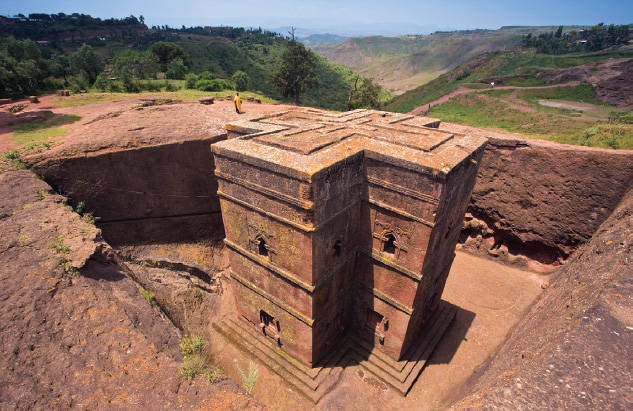African Christianity
The churches of Africa, like those of the Middle East, also found themselves on the defensive and declining in the face of an expanding Islam. Across coastal North Africa, widespread conversion to Islam over several centuries reduced to virtual extinction Christian communities that had earlier provided many of the martyrs and intellectuals of the early Church.
In Egypt, however, Christianity had become the religion of the majority by the time of the Muslim conquest around 640, and for the next 500 years or so, large numbers continued to speak Coptic and practice their religion as dhimmis, legally inferior but protected people paying a special tax, under relatively tolerant Muslim rulers. Many found Arab government less oppressive than that of their former Byzantine overlords, who considered Egyptian Christians heretics. By the thirteenth century, things changed dramatically as Christian crusaders from Europe and Mongol invaders from the east threatened Egypt. In these circumstances, the country’s Muslim rulers came to suspect the political loyalty of their Christian subjects. The mid-fourteenth century witnessed violent anti-Christian pogroms, destruction of churches, and the forced removal of Christians from the best land. Many felt like “exiles in their own country.” As a result, most rural Egyptians converted to Islam and moved toward the use of Arabic rather than Coptic, which largely died out. Although Egypt was becoming an Arab and Muslim country, a substantial Christian minority persisted among the literate in urban areas and in monasteries located in remote regions. In the early twenty-first century, Egyptian Christians still numbered about 10 percent of the population.
Even as Egyptian Christianity was contracting, a new center of African Christianity was taking shape during the fifth and sixth centuries in the several kingdoms of Nubia to the south of Egypt, where the faith had been introduced by Egyptian traders and missionaries. Parts of the Bible were translated into the Nubian language, while other writings appeared in Greek, Arabic, and the Ethiopian language of Ge’ez. A great cathedral in the Nubian city of Faras was decorated with magnificent murals, and the earlier practice of burying servants to provide for rulers in the afterlife stopped abruptly. At times, kings served as priests, and Christian bishops held state offices. By the mid-seventh century, both the ruling class and many commoners had become Christian. At the same time, Nubian armies twice defeated Arab incursions, following which an agreement with Muslim Egypt protected this outpost of Christianity for some 600 years. But pressures mounted in the 1200s and 1300s as Egypt adopted a more hostile stance toward Christians, while Islamized tribes from the desert and Arab migrants pushed against Nubia. By 1500 Nubian Christianity, like its counterparts in coastal North Africa, had largely disappeared.
An important exception to these various contractions of Asian and African Christianity lay in Ethiopia. There the rulers of Axum had adopted Christianity in the fourth century, and it subsequently took root among the general population as well. (See Map 4.1 and Axum: The Making of a Christian Kingdom.) Over the centuries of Islamic expansion, Ethiopia became a Christian island in a Muslim sea, protected by its mountainous geography and its distance from major centers of Islamic power. Many Muslims also remembered gratefully that Christian Ethiopia had sheltered some of the beleaguered and persecuted followers of Muhammad in Islam’s early years. Nonetheless, the spread of Islam largely cut Ethiopia off from other parts of Christendom and rendered its position in northeast Africa precarious.
In its isolated location, Ethiopian Christianity developed some of its most distinctive features. One of these was a fascination with Judaism and Jerusalem, reflected in a much-told story about the visit of an Ethiopian Queen of Sheba to King Solomon. The story includes an episode in which Solomon seduces the Queen, producing a child who becomes the founding monarch of the Ethiopian state. Since Solomon figures in the line of descent to Jesus, it meant that Ethiopia’s Christian rulers could legitimate their position by tracing their ancestry to Jesus himself. Furthermore, Ethiopian monks long maintained a presence in Jerusalem’s Church of the Holy Sepulcher, said to mark the site where Jesus was crucified and buried. Then, in the twelfth century, the rulers of a new Ethiopian dynasty constructed a remarkable series of twelve linked underground churches, apparently attempting to create a New Jerusalem on Christian Ethiopian soil, as the original city lay under Muslim control. Those churches are in use to this day in modern Ethiopia, where over 60 percent of the country’s population retain their affiliation with this ancient Christian church.
